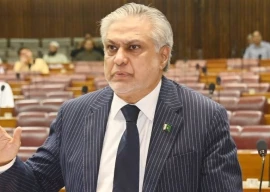
The government has spent some Rs332 million on overhead pedestrian bridges on the revamped Canal Road and Multan Road, but they remain largely unused. Most pedestrians continue to cross the road at ground level, sometimes after vandalising newly built barriers.
Eight bridges were built on Multan Road between Tokhar Niaz Beg and Scheme Mor at a cost of Rs17 million each. The road is divided by an open drain, covered on either side by concrete barriers two feet high. After setting up the overhead bridges, workers removed around 50 illegal crossings. Most of these have now been reestablished, ranging in design from a wood plank laid across the drain, to welded metal bridges with railings that are accessible through entrances carved into the barriers. Many of these are directly under the pedestrian bridges.
“We removed all the illegal crossings so that they would use the overhead bridges, but people insist on using short cuts,” said Multan Road Project Deputy Director Ilyas Shah. He said that they would launch another drive against the illegal road crossings. “People should realise that these bridges were built for their own good,” he added.
On Sunday, this correspondent witnessed pedestrians, young and old, cross the road at ground level and almost no one use the overhead bridges on Multan Road. Muhammad Shafi, a resident of Awan Town, walked across the road, climbed over the barriers, then across a plank over the drain. “I don’t have the stamina to go up the bridge. I’m too old,” he said.
Shafi said he knew that he should be using the bridge, “but since others are doing it I don’t see why I should take the longer route.”
The Canal
Similarly, eight pedestrian bridges were built on Canal Bank Road after the road was expanded by an extra lane, at a cost of Rs24 million each. But three bridges on the Canal remain, almost directly under the overhead pedestrian bridges, and people generally prefer using these. There is also a bridge across the Canal in front of GOR-I that is used by cyclists as well as pedestrians.
Muhammad Boota lives on Multan Road and cycles every day to Johar Town Society where he works as a driver. He said that were he to use the overhead pedestrian bridge instead of one of the bridges across the Canal at ground level, he would add half an hour to his journey.
“I should cycle four kms to Doctors’ Hospital, then four kms back to my destination across the road? That would take over half an hour more than just crossing the bridge.”
Ring Road
Pedestrians using ground crossings is even a problem on the Ring Road, which is covered on either side by a six-and-a-half-feet wall. There are 20 overhead pedestrian bridges, costing Rs17 million each, on the Northern Loop of the Ring Road, said Ring Road Authority Deputy Director Najam Waheed.
“I’ve seen elderly men and women and children climb the wall after setting up stacks of bricks as steps, or driving iron rods into the wall to use as stepping stones,” he said. “Around once a month, someone tries to make a hole in the wall. Our department stops them.” Overhead bridges built on Maulana Shaukat Ali Road, Circular Road, Ravi Road, Jail Road and Ferozepur Road are also largely unused.
Published in The Express Tribune, April 23rd, 2012.
COMMENTS (26)
Comments are moderated and generally will be posted if they are on-topic and not abusive.
For more information, please see our Comments FAQ







































Jaywalking is dangerous and in karachi it is common
http://pakistaninme.blogspot.com/2012/05/learning-survival-skills-in-karachi.html
The planners and engineers who are trying to force other people to cross the street using their bridges sound like the story of certain countries who try to force "democracy" down the throats of other countries. You can imagine they will say "We did it for their own good! We improved their situation! Look how much better they are!". While I'm sure their bridges are strong, well-designed and will last a long time, the major failure is not looking at it from the perspective of the people who need to cross the street.
Next time, before spending millions on a bridge, spend a few hundred and have someone reach out to interview people on the street to see if the solution will work.
Even if they were given Star Trek's transporter room facility to be teleported on the other side, they will still love to cross over like this.
No one wants to climb up the bridge then back down...spend some more money and build an underpass for cars instead or an overpass
I think not to do such actions doesn't required a PhD from top university.
@Mandeep Vaid: I too would prefer the shortest route to my destination
instead of ascending and descending these high bridges without electric stairs.
'Speeding vehicle hits pedestrian'. Quite a common headline. Now we know the other fifty percent of the story.
haha !!
I have seen similar scenes in Chennai (South India) too ! No one there walks on the pavement or uses the overbridges !
Like Aakar Patel says, in all negative aspects, our people are so much alike !!!
Why don't we just admit that our people are ignorant.
Maybe I should have been more clear. I would obviously use the bridge if I had to cross over. I was just trying to make a point that it is a very inconvenient way of trying to cross.
I liked all above comments as they show sincere suggestions by everyone to improve our society as a whole. I appreciate that bridges have been made for pedestrians but I think better approach would be to modify signals to allow pedestrians to cross streets. I just came from Denmark and on every road whenever the pedestrian signal gets on, people starts crossing the roads and all cars gives way to walking people on priority. This looks so good and organized and helps people to realize more the rights of the pedestrians.
@saad: They are built for civilised people. Its upto them how they want to known.
Where is media? If they can cover each and everything happening around, why can't they run public service ads to teach people?
Why not we build a 3 feet high wall/fence in the area 200M around such bridges?
i am currently studying in Islamabad the same thing happens here though many use the bridge but still i have seen old women running to the other side
this is why our country is in this position people don't want to change law is there but we dont obey them & @ Saad bhai do we even stop at signals, stop sign we do the same as we have done to any other law.
How about teaching the genius planners, designers and engineers that this ain't the U S of A where everybody uses a vehicle with 4 wheels or more. You can't bifurcate residential communities with a high speed expressway, especially where the majority residents travel on two wheelers or foot!
The same goes for Karachi also . In fact here the situation is worse. I would endorse Mr.A.Khawaja's suggestion and would go a step further. The violaters should be punished on the site and this would be an example for others at that place.We are used to critisizing authoraties but are preapred to change ourselves and same people going to other countries follow thier rules and even walk upto 500 meters to find suitable place to cross. Disappointed to read Mr. Saad's comments.
Humans have an economical thinking which the stereotyped bridge-planners totally overlooked.
This clearly means we need to invest in education first then infrastructure.
How about teaching it at school? - ignorants
There should be a law, anyone not using pedestrian bridge to cross a road and is within 200m of such a bridge if gets mowed down by a car/truck/bus will be liable for the damage done to the car, and if he dies, then the truck/bus driver will be immune.
Yes I know, thats very mean & low of me
@saad: I sometimes see third world people try to run across the highways and motorways in North America illegally instead of using the designated crossing places. It's the same mentality.Put some of the folks in jail and then they'll learn. Otherwise they'll spoil the Ring Road.
What about a traffic light? Stop Sign? Yield to pedestrian traffic? What's the point of a pedestrian bridge?... I would never use that thing.
If few of them are arrested and given some nice treatment in police station they will stop it immediatley, the problem is there is too much liberty in this country.